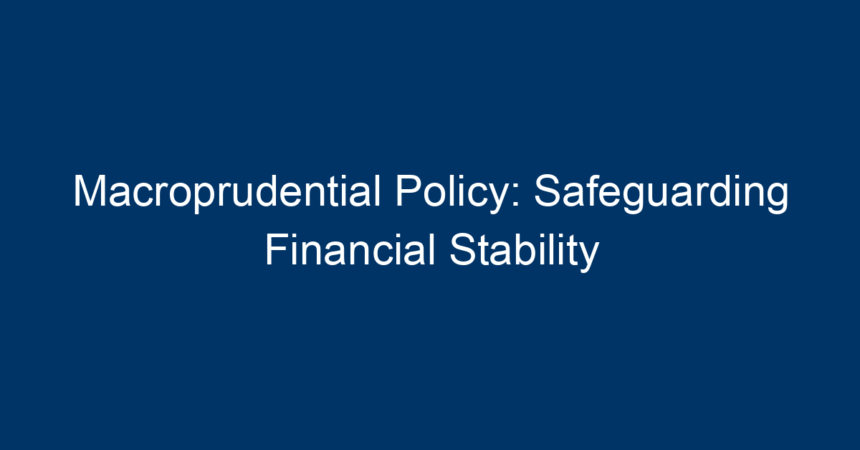In an ever-evolving economic landscape marked by global interconnections, financial crises remain a pressing concern for economies worldwide. A proactive approach is essential to mitigate systemic risks and ensure sustained economic growth. This is where macroprudential policy comes into play, serving as a crucial framework designed to maintain financial stability. In this article, we explore the intricacies of macroprudential policy, its importance, key tools, and its role in safeguarding financial systems.
Understanding Macroprudential Policy
What is Macroprudential Policy?
Macroprudential policy refers to a set of regulatory measures aimed at addressing systemic risks within the financial system. Unlike microprudential regulations, which focus on individual financial institutions, macroprudential policy takes a broader view, considering the interconnectedness of various entities and the overall health of the financial system. The goal is to prevent the build-up of risk that could lead to instability and crises, particularly in an increasingly complex financial environment.
The Importance of Macroprudential Policy
In recent decades, the world has witnessed several financial crises—from the Great Depression of the 1930s to the 2008 global financial meltdown. Each crisis exposed vulnerabilities in financial systems, underscoring the need for effective policies that promote stability. Macroprudential policy plays a vital role in:
-
Mitigating Systemic Risk: By monitoring and addressing factors that could precipitate a financial crisis, macroprudential policy helps reduce the likelihood of systemic collapse.
-
Promoting Economic Resilience: Healthy financial systems contribute to overall economic resilience, enabling economies to withstand shocks and recover from downturns more swiftly.
- Enhancing Financial Regulation: Through comprehensive oversight, macroprudential policies complement existing regulations, fortifying the financial system against potential threats.
Key Objectives of Macroprudential Policy
1. Financial Stability
The primary objective of macroprudential policy is to ensure financial stability. This encompasses the smooth functioning of financial markets, the resilience of financial institutions, and the trust of consumers and investors. Financial stability not only protects individual institutions but also the economy at large.
2. Risk Mitigation
Macroprudential policy seeks to identify and mitigate risks before they escalate. By utilizing a range of tools, regulators can proactively address vulnerabilities, such as excessive leverage, asset bubbles, and liquidity risks.
3. Credit Cycle Management
Effectively managing the credit cycle is vital for maintaining financial stability. Macroprudential measures can help cool down overheating credit markets during economic booms and provide support during downturns.
Tools of Macroprudential Policy
To achieve its objectives, macroprudential policy employs various tools and strategies. Understanding these tools is essential for grasping how macroprudential policies are implemented effectively.
1. Capital Buffers
One of the most common tools is the requirement for financial institutions to maintain higher capital buffers during good economic times. This means that banks must set aside a larger amount of capital for potential losses, ensuring they remain solvent during downturns.
2. Countercyclical Capital Requirements
Countercyclical capital requirements adjust capital buffer requirements based on the economic cycle. During periods of rapid credit growth, banks may be required to hold additional capital to prevent excessive risk-taking. Conversely, during downturns, requirements may be relaxed to encourage lending.
3. Loan-to-Value (LTV) and Debt-to-Income (DTI) Ratios
Regulating LTV and DTI ratios restricts the amount of debt that borrowers can take on in relation to their income and the value of collateral. This helps prevent the overextension of credit and reduces the risk of defaults.
4. Stress Testing
Regular stress tests evaluate the resilience of financial institutions under hypothetical adverse economic scenarios. This assessment allows regulators to identify vulnerabilities and take corrective actions before potential crises arise.
5. Leverage Ratios
Implementing leverage ratio requirements ensures that financial institutions do not excessively rely on borrowed funds. By capping leverage, regulators can limit the risk of market distortions caused by excessive debt.
Implementation Challenges of Macroprudential Policy
While macroprudential policy is essential for financial stability, its implementation is fraught with challenges.
1. Data Limitations
Access to accurate and timely data is crucial for effective macroprudential regulation. However, data gaps can hinder the ability to identify emerging risks. Enhancing data collection and analysis is imperative for informed decision-making.
2. Coordination Among Regulators
Multiple regulatory agencies often oversee different aspects of financial markets, which can lead to fragmented approaches to macroprudential policy. Coordinated efforts among various regulators are vital to address systemic risks comprehensively.
3. Global Interconnections
In an increasingly globalized economy, the interconnectedness of financial systems poses challenges for national regulators. International cooperation is essential for managing risks that transcend borders.
Case Studies: Successful Macroprudential Policies
1. The Basel III Framework
The Basel III framework, introduced in response to the 2008 financial crisis, exemplifies successful macroprudential regulation. By requiring banks to maintain higher capital ratios and introducing liquidity requirements, Basel III aims to enhance the resilience of the banking sector.
2. Sweden’s Housing Market Measures
Sweden has implemented a range of macroprudential measures to address rising housing prices and household debt. Measures such as stricter mortgage lending standards and higher capital requirements for banks have proven effective in maintaining stability in the housing market.
Conclusion: The Path Forward for Macroprudential Policy
As global economies face increasing uncertainty and financial interconnectedness, the role of macroprudential policy will only grow in significance. With ongoing developments in financial markets, it is crucial for policymakers to adapt and refine their strategies to effectively mitigate systemic risks.
Actionable Insights
-
Enhance Data Collection: Investing in robust data systems will enable regulators to better monitor financial risks and trends.
-
Foster Coordination: Encouraging collaboration among regulatory agencies can ensure a cohesive approach to macroprudential policies.
-
Stay Informed: Financial institutions should continuously educate themselves about macroprudential regulations and best practices to bolster their resilience.
- Engage in International Dialogue: Global cooperation and shared insights can help manage cross-border risks more effectively.
In a world where financial stability is paramount, the continued evolution and implementation of macroprudential policy will be critical in shaping robust financial systems capable of weathering uncertainties. Addressing systemic risks proactively not only fosters confidence in financial markets but also paves the way for sustainable economic growth.




